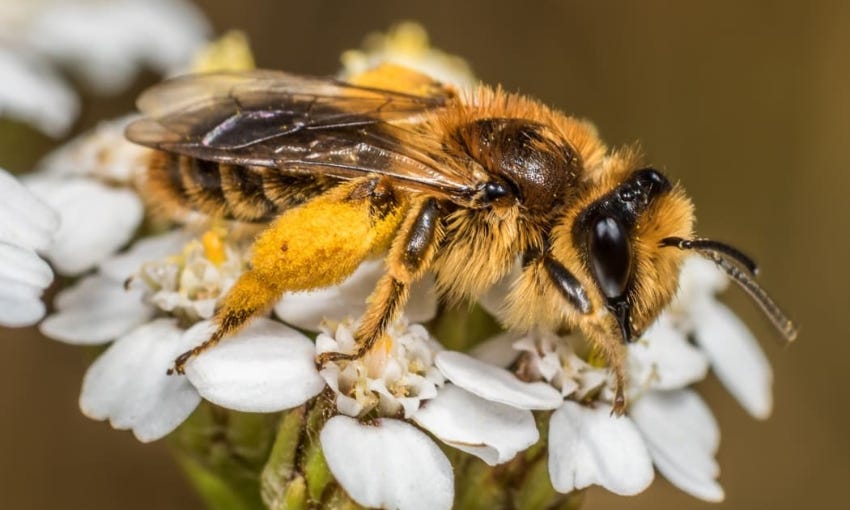Kia ora! Welcome back to Future Proof, brought to you by Electric Kiwi.
Image credit: NRCS Oregon/Flickr (CC BY-ND 2.0).
Every year, carbon capture efforts around the world net around 2 billion tonnes of carbon dioxide. We’ll need to scale up this carbon removal if we want to limit warming, a new report says (alongside reducing gross emissions, of course). Most of the carbon currently being removed is sequestered in managed forests – but a handful of new approaches are steadily gaining steam. Among them is biochar production.
What is biochar?
It’s a carbon-rich residue – like charcoal, biochar is the product of “pyrolysing” biological matter (like wood or other vegetation). Rather than burning this organic matter in a classic fire-fuelled combustion reaction, it’s heated in the absence of oxygen. This results in much more carbon locked up in the jet-black lumps (alongside quantities of bio-oil and gas). These lumps are then applied to soils, where the carbon can remain for hundreds or even thousands of years.
Supercharging soil
According to Warrick Isaachsen, chair of the Biochar Network of New Zealand, this carbon sequestration is just one among many benefits of biochar. “If used well, it can boost plant and animal growth,” he says. Because it’s highly porous, biochar holds onto water and nutrients in the soil, and enhances the actions of microbes. “It acts like a bit of a sponge or hotel, protecting the soil bugs.” In Pukekohe, Isaachsen says, crop farmers using biochar in their soils haven’t had to use as much fertiliser to achieve the same yields, and haven’t had to replenish truckloads of soil that were previously washed away by rains.
Forestry debris, sorted
Isaachsen also points out that slash (forestry waste – here’s a good explainer) could be used as raw material to make biochar. Simply truck up a portable processor to a cleared plot and pyrolyse the wood waste. In fact, New Zealand’s largest producer of biochar is a sawmill, says Isaachsen, churning out up to 3,000 tonnes of biochar per year and using excess energy produced to help power the wood processing plant. The government is set to announce a review of how best to deal with slash this week (paywall) – perhaps biochar will be on the table.
A solution ripe for scaling up?
Despite its benefits, biochar hasn’t really caught on in a big way in New Zealand – yet. We’re currently producing about 5,000 tonnes of biochar each year, but “there's enough residue biomass to sustainably do 400,000 tonnes of biochar per annum (equivalent to one million tonnes CO2) without chopping down trees,” says Isaachsen. It also hasn’t been included in the ETS or voluntary carbon markets. This is partly because you need to look at the whole life-cycle of biochar. This includes how it’s made – there are different production methods with varying qualities and environmental footprints – and how long the final product hangs around for. But Isaachsen says the science is there, and now biochar just needs an entrepreneurial ecosystem to bring it to the people. “People want to be part of that solution and we need to put science-backed, solid solutions in their hands.”
ChargeNet’s network has more than 280 rapid charging points around the country, with more on the way. Add the costs of your public EV charging with ChargeNet to your Electric Kiwi bill, instead of charging your credit card every time. One bill, no fuss.
Remember to link your Electric Kiwi and Chargenet accounts before the end of February to go in the draw to win a $500 ChargeNet credit. T&Cs apply.
Wales has scrapped all major roading projects due to environmental concerns
In a major reassessment of more than 50 roading schemes, only 15 will go ahead under strict new criteria announced by the Welsh government. All future roads in Wales must not increase carbon emissions, negatively impact the environment, or increase the number of cars on the road. “We will not get to net zero unless we stop doing the same thing over and over,” the deputy climate change minister, Lee Waters, said.
Where managed retreat is the best solution
Newsroom’s Jonathan Milne meets a West Auckland couple calling on the government to implement a managed retreat scheme – so they don’t have to return to their flood-damaged home where they’ll never feel safe again. Another West Auckland couple in a similar situation speak to Stuff’s Kirsty Johnston. Climate change minister James Shaw tells Newshub Nation about his intention to accelerate some aspects of the National Adaptation Plan in order to better facilitate managed retreat during the recovery phase. If you need a quick and easy explainer on climate change adaptation, mitigation and why we need both – The Spinoff’s Anna Rawhiti-Connell has you covered.
We’re not dealing with ‘cute Mrs Tiggy Winkle’
Hedgehogs might seem cute, but these beloved backyard visitors are predators with a voracious appetite for native wildlife, writes Craig Hoyle for Stuff. One hedgehog in the Waitaki river basin had 283 wētā legs in its stomach – equivalent to 47 of the native invertebrates consumed within 24 hours. Meanwhile, New Zealand’s cat conundrum is covered by the BBC, with some stark stats on display: “They've directly contributed to the extinction of 11 bird species, and possibly contributed to the extinction of 10 more.”
The Spinoff's independent, homegrown journalism is only possible because of the support of our members. Their generous donations power all our work and help keep it freely available to all. Tautoko The Spinoff this year by becoming a member, making a new donation or encouraging your organisation to donate.
More stories:
As Covid lockdowns have faded away, conspiracy theorists have latched onto a new, bizarre target: 15-minute cities (an urban design concept where citizens don’t have to walk more than 15 minutes to reach amenities like supermarkets)
EU formally approves ban on sale of new petrol and diesel cars, effective from 2035
Government weakens wetland protections, making it easier for wetlands to be destroyed to make way for mines, landfills and housing development
Chris McDowall ruminates on the contrasting climates of summer in 2020 and 2023 on The Spinoff
Native tree planting on Herald Island may have prevented even worse cyclone damage
Are coffee pods really eco-friendly? According to one analysis, traditional filter coffee emits 1.5 times more greenhouse gases than a single-use coffee pod
Large stores of natural carbon-free hydrogen may exist all over the world – perhaps enough to meet growing demand for thousands of years
Image credit: Danilo Hegg/Southern Alps Photography via RNZ’s Critter of the Week.
To finish this issue, all hail Aotearoa’s inaugural Bug of the Year! The native bee ngaro huruhuru (Leioproctus fulvescens) was crowned the winner on Valentines Day. Unlike honey bees, these fuzzy lil fellas lead solitary lives and nest in tunnels burrowed into soil or sand. Have a squizz at this awesome footage of a native bee digging.
Hope your week is the bee’s knees,
Ellen
Got some feedback about Future Proof or topics you’d like covered? Get in touch with me at futureproof@thespinoff.co.nz













An underestimated and slow to disperse knowledge that has the potential to aid in an urgent agricultural need to pivot to an environmentally harmonic sustainability while promoting the health of the population as well as the Globe.
Thank You for spreading the news!
Sounds like the terra preta soil produced by the pre-Columbian Amazonian farmers.